Answered step by step
Verified Expert Solution
Question
1 Approved Answer
provide a brief summary of CSR-related marketing theory, and provide at least one way to expand the theory or make it better, and at least
provide a brief summary of CSR-related marketing theory, and provide at least one way to expand the theory or make it better, and at least one way you will use it in the current format . 1.5 page
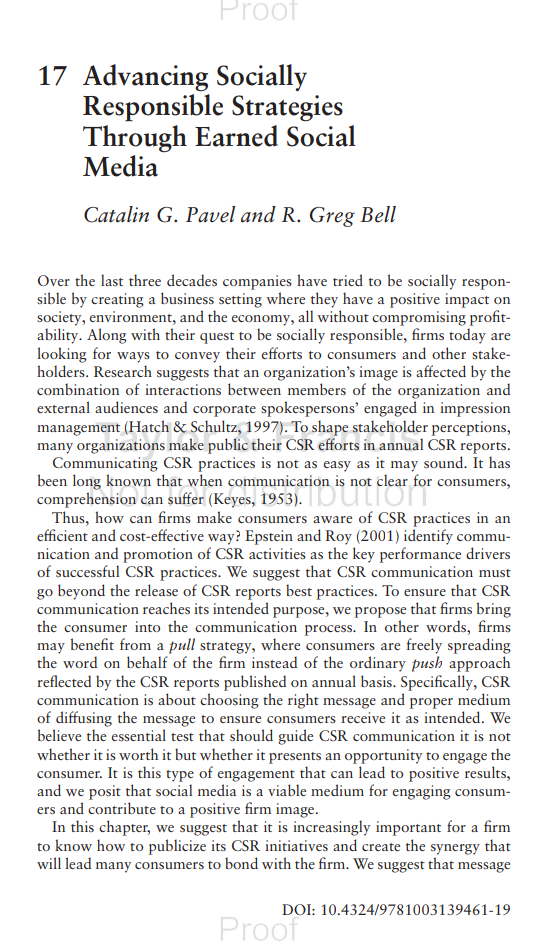
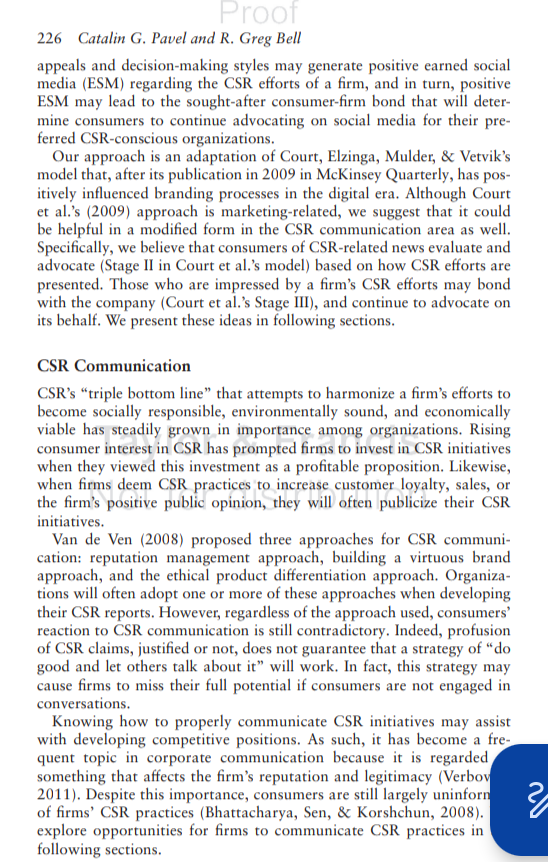
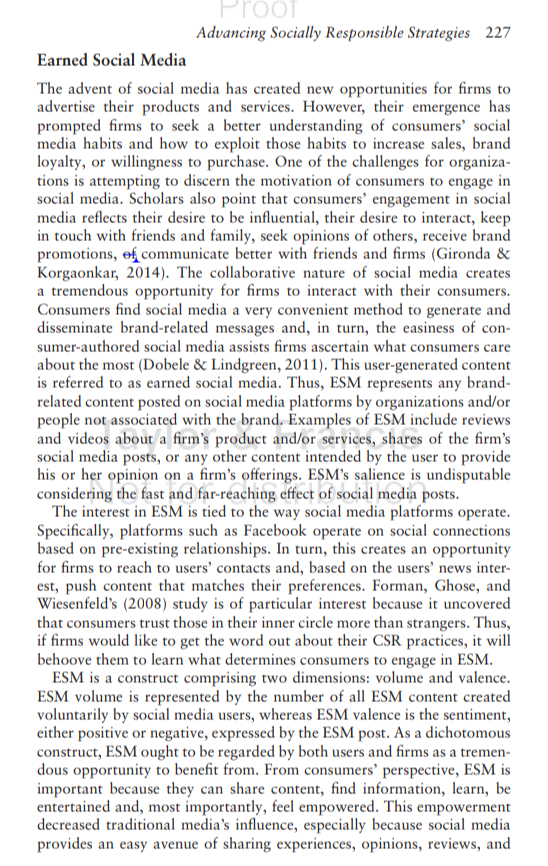
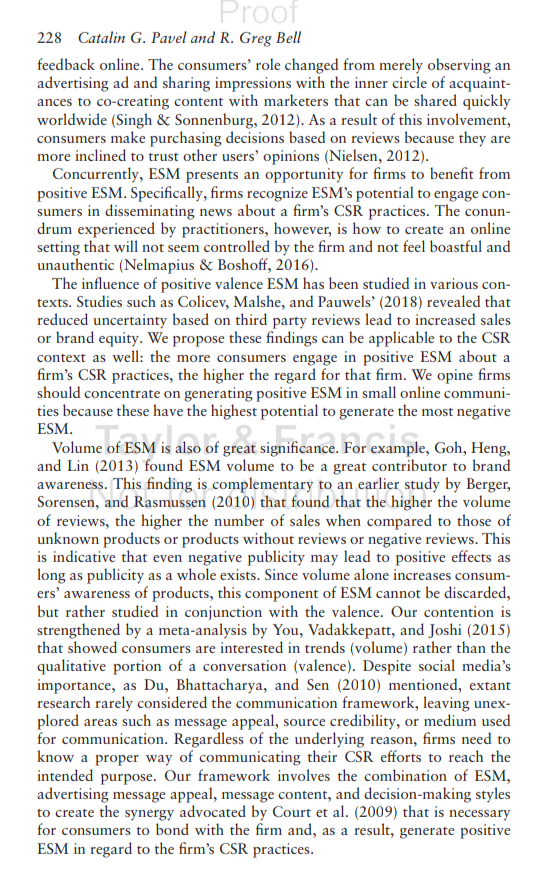
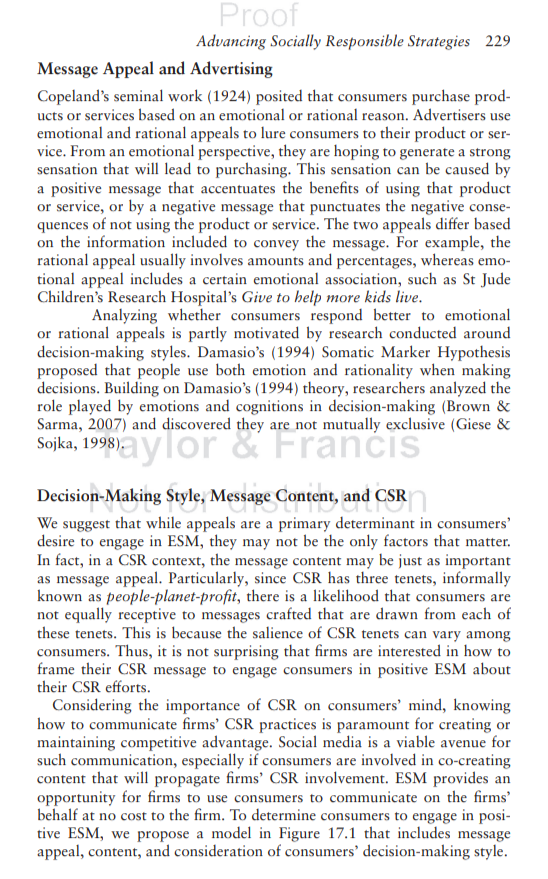
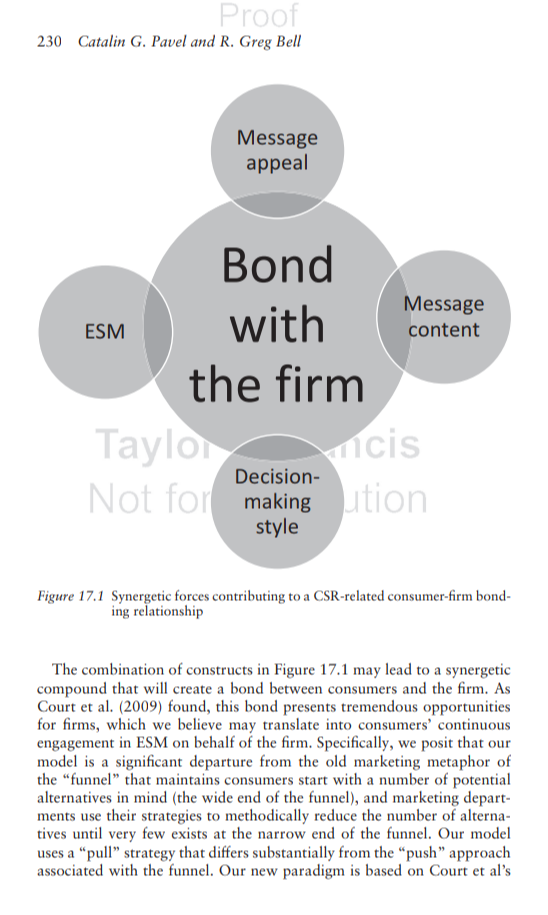
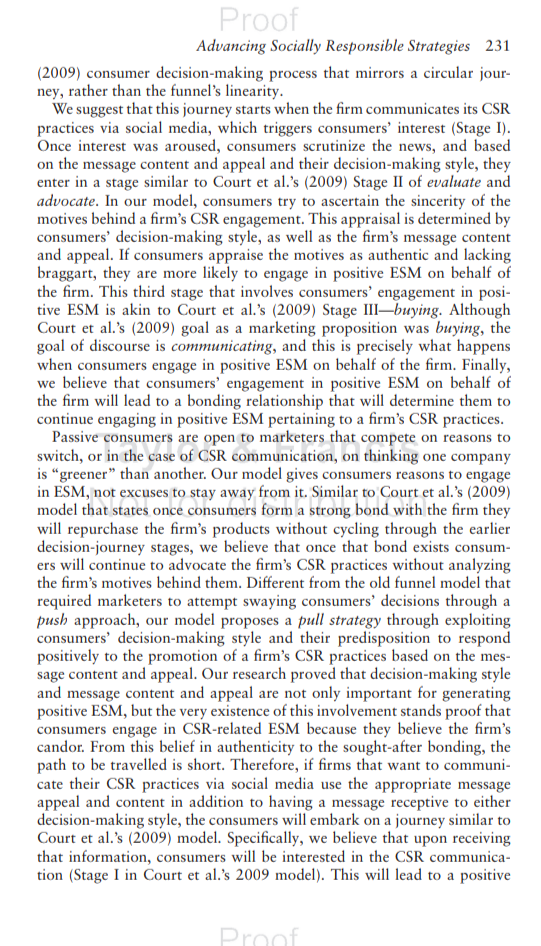
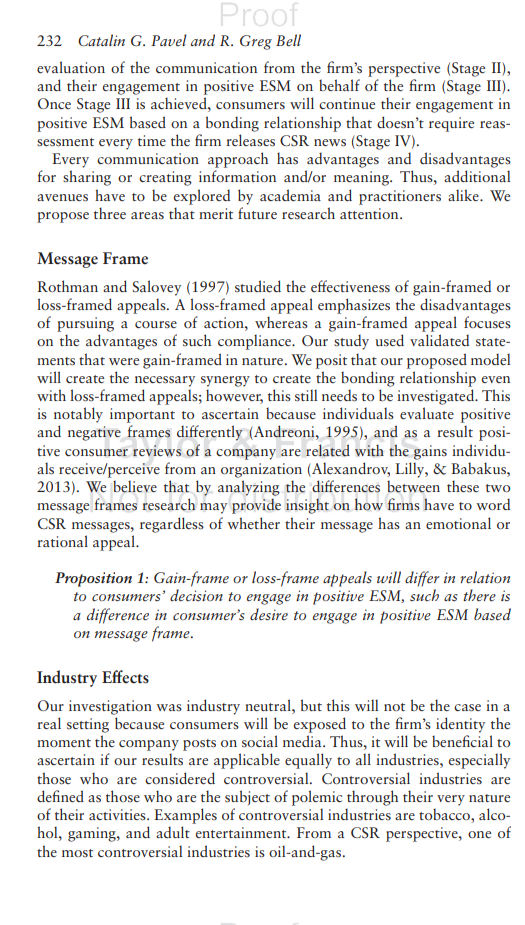
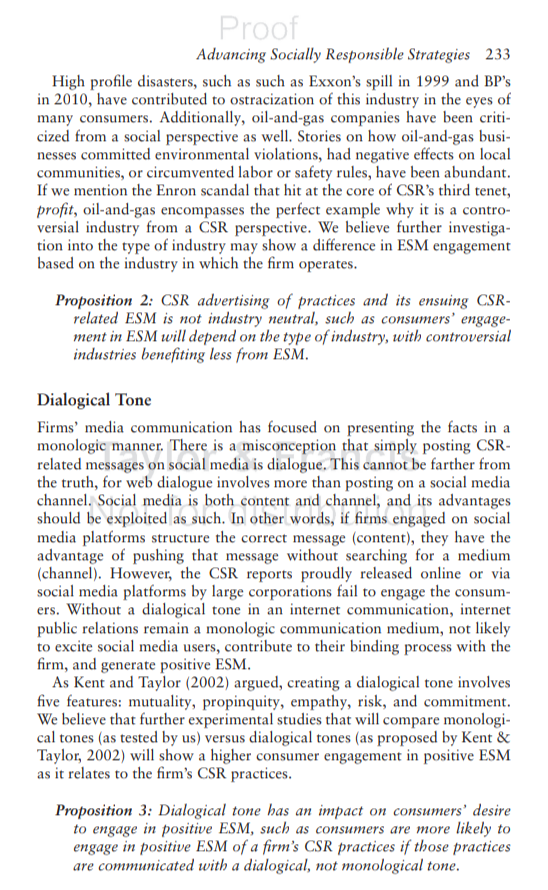
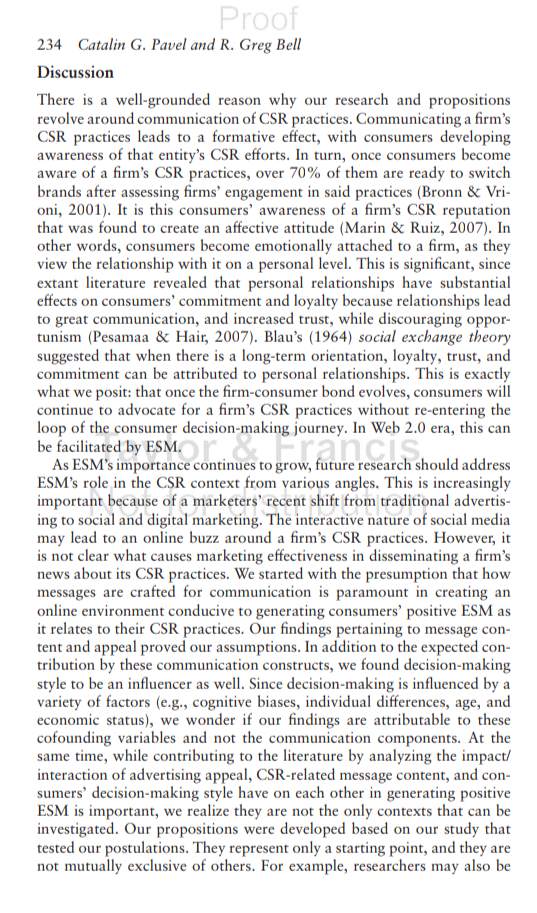
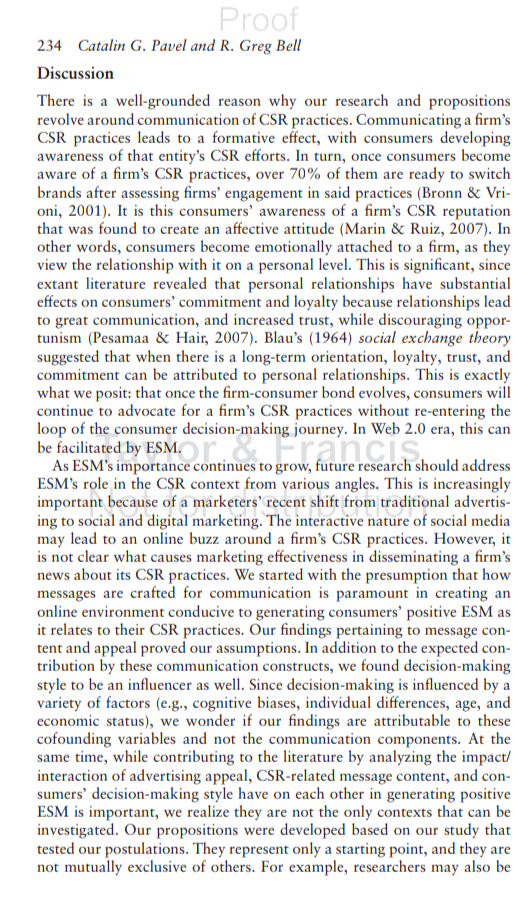
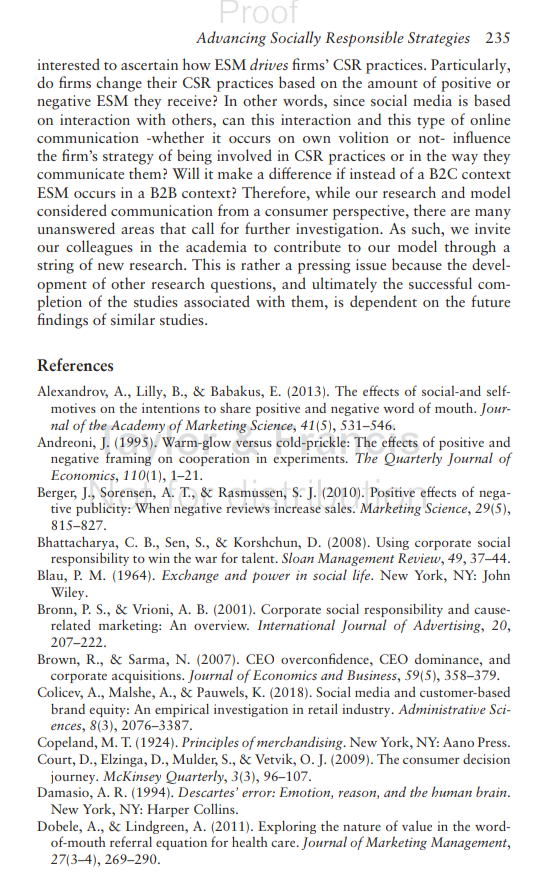
17 Advancing Socially Responsible Strategies Through Earned Social Media Catalin G. Pavel and R. Greg Bell Over the last three decades companies have tried to be socially responsible by creating a business setting where they have a positive impact on society, environment, and the economy, all without compromising profitability. Along with their quest to be socially responsible, firms today are looking for ways to convey their efforts to consumers and other stakeholders. Research suggests that an organization's image is affected by the combination of interactions between members of the organization and external audiences and corporate spokespersons' engaged in impression management (Hatch \& Schultz, 1997). To shape stakeholder perceptions, many organizations make public their CSR efforts in annual CSR reports. Communicating CSR practices is not as easy as it may sound. It has been long known that when communication is not clear for consumers, comprehension can suffer (Keyes, 1953). Thus, how can firms make consumers aware of CSR practices in an efficient and cost-effective way? Epstein and Roy (2001) identify communication and promotion of CSR activities as the key performance drivers of successful CSR practices. We suggest that CSR communication must go beyond the release of CSR reports best practices. To ensure that CSR communication reaches its intended purpose, we propose that firms bring the consumer into the communication process. In other words, firms may benefit from a pull strategy, where consumers are freely spreading the word on behalf of the firm instead of the ordinary push approach reflected by the CSR reports published on annual basis. Specifically, CSR communication is about choosing the right message and proper medium of diffusing the message to ensure consumers receive it as intended. We believe the essential test that should guide CSR communication it is not whether it is worth it but whether it presents an opportunity to engage the consumer. It is this type of engagement that can lead to positive results, and we posit that social media is a viable medium for engaging consumers and contribute to a positive firm image. In this chapter, we suggest that it is increasingly important for a firm to know how to publicize its CSR initiatives and create the synergy that will lead many consumers to bond with the firm. We suggest that message 226 Catalin G. Pavel and R. Greg Bell appeals and decision-making styles may generate positive earned social media (ESM) regarding the CSR efforts of a firm, and in turn, positive ESM may lead to the sought-after consumer-firm bond that will determine consumers to continue advocating on social media for their preferred CSR-conscious organizations. Our approach is an adaptation of Court, Elzinga, Mulder, \& Vetvik's model that, after its publication in 2009 in McKinsey Quarterly, has positively influenced branding processes in the digital era. Although Court et al.'s (2009) approach is marketing-related, we suggest that it could be helpful in a modified form in the CSR communication area as well. Specifically, we believe that consumers of CSR-related news evaluate and advocate (Stage II in Court et al.'s model) based on how CSR efforts are presented. Those who are impressed by a firm's CSR efforts may bond with the company (Court et al.'s Stage III), and continue to advocate on its behalf. We present these ideas in following sections. CSR Communication CSR's "triple bottom line" that attempts to harmonize a firm's efforts to become socially responsible, environmentally sound, and economically viable has steadily grown in importance among organizations. Rising consumer interest in CSR has prompted firms to invest in CSR initiatives when they viewed this investment as a profitable proposition. Likewise, when firms deem CSR practices to increase customer loyalty, sales, or the firm's positive public opinion, they will often publicize their CSR initiatives. Van de Ven (2008) proposed three approaches for CSR communication: reputation management approach, building a virtuous brand approach, and the ethical product differentiation approach. Organizations will often adopt one or more of these approaches when developing their CSR reports. However, regardless of the approach used, consumers' reaction to CSR communication is still contradictory. Indeed, profusion of CSR claims, justified or not, does not guarantee that a strategy of "do good and let others talk about it" will work. In fact, this strategy may cause firms to miss their full potential if consumers are not engaged in conversations. Knowing how to properly communicate CSR initiatives may assist with developing competitive positions. As such, it has become a frequent topic in corporate communication because it is regarded something that affects the firm's reputation and legitimacy (Verbov 2011). Despite this importance, consumers are still largely uninforn of firms' CSR practices (Bhattacharya, Sen, \& Korshchun, 2008). explore opportunities for firms to communicate CSR practices in following sections. Advancing Socially Responsible Strategies 227 Earned Social Media The advent of social media has created new opportunities for firms to advertise their products and services. However, their emergence has prompted firms to seek a better understanding of consumers' social media habits and how to exploit those habits to increase sales, brand loyalty, or willingness to purchase. One of the challenges for organizations is attempting to discern the motivation of consumers to engage in social media. Scholars also point that consumers' engagement in social media reflects their desire to be influential, their desire to interact, keep in touch with friends and family, seek opinions of others, receive brand promotions, communicate better with friends and firms (Gironda \& Korgaonkar, 2014). The collaborative nature of social media creates a tremendous opportunity for firms to interact with their consumers. Consumers find social media a very convenient method to generate and disseminate brand-related messages and, in turn, the easiness of consumer-authored social media assists firms ascertain what consumers care about the most (Dobele \& Lindgreen, 2011). This user-generated content is referred to as earned social media. Thus, ESM represents any brandrelated content posted on social media platforms by organizations and/or people not associated with the brand. Examples of ESM include reviews and videos about a firm's product and/or services, shares of the firm's social media posts, or any other content intended by the user to provide his or her opinion on a firm's offerings. ESM's salience is undisputable considering the fast and far-reaching effect of social media posts. The interest in ESM is tied to the way social media platforms operate. Specifically, platforms such as Facebook operate on social connections based on pre-existing relationships. In turn, this creates an opportunity for firms to reach to users' contacts and, based on the users' news interest, push content that matches their preferences. Forman, Ghose, and Wiesenfeld's (2008) study is of particular interest because it uncovered that consumers trust those in their inner circle more than strangers. Thus, if firms would like to get the word out about their CSR practices, it will behoove them to learn what determines consumers to engage in ESM. ESM is a construct comprising two dimensions: volume and valence. ESM volume is represented by the number of all ESM content created voluntarily by social media users, whereas ESM valence is the sentiment, either positive or negative, expressed by the ESM post. As a dichotomous construct, ESM ought to be regarded by both users and firms as a tremendous opportunity to benefit from. From consumers' perspective, ESM is important because they can share content, find information, learn, be entertained and, most importantly, feel empowered. This empowerment decreased traditional media's influence, especially because social media provides an easy avenue of sharing experiences, opinions, reviews, and 228 Catalin G. Pavel and R. Greg Bell feedback online. The consumers' role changed from merely observing an advertising ad and sharing impressions with the inner circle of acquaintances to co-creating content with marketers that can be shared quickly worldwide (Singh \& Sonnenburg, 2012). As a result of this involvement, consumers make purchasing decisions based on reviews because they are more inclined to trust other users' opinions (Nielsen, 2012). Concurrently, ESM presents an opportunity for firms to benefit from positive ESM. Specifically, firms recognize ESM's potential to engage consumers in disseminating news about a firm's CSR practices. The conundrum experienced by practitioners, however, is how to create an online setting that will not seem controlled by the firm and not feel boastful and unauthentic (Nelmapius \& Boshoff, 2016). The influence of positive valence ESM has been studied in various contexts. Studies such as Colicev, Malshe, and Pauwels' (2018) revealed that reduced uncertainty based on third party reviews lead to increased sales or brand equity. We propose these findings can be applicable to the CSR context as well: the more consumers engage in positive ESM about a firm's CSR practices, the higher the regard for that firm. We opine firms should concentrate on generating positive ESM in small online communities because these have the highest potential to generate the most negative ESM. Volume of ESM is also of great significance. For example, Goh, Heng, and Lin (2013) found ESM volume to be a great contributor to brand awareness. This finding is complementary to an earlier study by Berger, Sorensen, and Rasmussen (2010) that found that the higher the volume of reviews, the higher the number of sales when compared to those of unknown products or products without reviews or negative reviews. This is indicative that even negative publicity may lead to positive effects as long as publicity as a whole exists. Since volume alone increases consumers' awareness of products, this component of ESM cannot be discarded, but rather studied in conjunction with the valence. Our contention is strengthened by a meta-analysis by You, Vadakkepatt, and Joshi (2015) that showed consumers are interested in trends (volume) rather than the qualitative portion of a conversation (valence). Despite social media's importance, as Du, Bhattacharya, and Sen (2010) mentioned, extant research rarely considered the communication framework, leaving unexplored areas such as message appeal, source credibility, or medium used for communication. Regardless of the underlying reason, firms need to know a proper way of communicating their CSR efforts to reach the intended purpose. Our framework involves the combination of ESM, advertising message appeal, message content, and decision-making styles to create the synergy advocated by Court et al. (2009) that is necessary for consumers to bond with the firm and, as a result, generate positive ESM in regard to the firm's CSR practices. Message Appeal and Advertising Copeland's seminal work (1924) posited that consumers purchase products or services based on an emotional or rational reason. Advertisers use emotional and rational appeals to lure consumers to their product or service. From an emotional perspective, they are hoping to generate a strong sensation that will lead to purchasing. This sensation can be caused by a positive message that accentuates the benefits of using that product or service, or by a negative message that punctuates the negative consequences of not using the product or service. The two appeals differ based on the information included to convey the message. For example, the rational appeal usually involves amounts and percentages, whereas emotional appeal includes a certain emotional association, such as St Jude Children's Research Hospital's Give to help more kids live. Analyzing whether consumers respond better to emotional or rational appeals is partly motivated by research conducted around decision-making styles. Damasio's (1994) Somatic Marker Hypothesis proposed that people use both emotion and rationality when making decisions. Building on Damasio's (1994) theory, researchers analyzed the role played by emotions and cognitions in decision-making (Brown \& Sarma, 2007) and discovered they are not mutually exclusive (Giese \& Sojka, 1998). Decision-Making Style, Message Content, and CSR We suggest that while appeals are a primary determinant in consumers' desire to engage in ESM, they may not be the only factors that matter. In fact, in a CSR context, the message content may be just as important as message appeal. Particularly, since CSR has three tenets, informally known as people-planet-profit, there is a likelihood that consumers are not equally receptive to messages crafted that are drawn from each of these tenets. This is because the salience of CSR tenets can vary among consumers. Thus, it is not surprising that firms are interested in how to frame their CSR message to engage consumers in positive ESM about their CSR efforts. Considering the importance of CSR on consumers' mind, knowing how to communicate firms' CSR practices is paramount for creating or maintaining competitive advantage. Social media is a viable avenue for such communication, especially if consumers are involved in co-creating content that will propagate firms' CSR involvement. ESM provides an opportunity for firms to use consumers to communicate on the firms' behalf at no cost to the firm. To determine consumers to engage in positive ESM, we propose a model in Figure 17.1 that includes message appeal, content, and consideration of consumers' decision-making style. 230 Catalin G. Pavel and R. Greg Bell Figure 17.1 Synergetic forces contributing to a CSR-related consumer-firm bonding relationship The combination of constructs in Figure 17.1 may lead to a synergetic compound that will create a bond between consumers and the firm. As Court et al. (2009) found, this bond presents tremendous opportunities for firms, which we believe may translate into consumers' continuous engagement in ESM on behalf of the firm. Specifically, we posit that our model is a significant departure from the old marketing metaphor of the "funnel" that maintains consumers start with a number of potential alternatives in mind (the wide end of the funnel), and marketing departments use their strategies to methodically reduce the number of alternatives until very few exists at the narrow end of the funnel. Our model uses a "pull" strategy that differs substantially from the "push" approach associated with the funnel. Our new paradigm is based on Court et al's Advancing Socially Responsible Strategies 231 (2009) consumer decision-making process that mirrors a circular journey, rather than the funnel's linearity. We suggest that this journey starts when the firm communicates its CSR practices via social media, which triggers consumers' interest (Stage I). Once interest was aroused, consumers scrutinize the news, and based on the message content and appeal and their decision-making style, they enter in a stage similar to Court et al.'s (2009) Stage II of evaluate and advocate. In our model, consumers try to ascertain the sincerity of the motives behind a firm's CSR engagement. This appraisal is determined by consumers' decision-making style, as well as the firm's message content and appeal. If consumers appraise the motives as authentic and lacking braggart, they are more likely to engage in positive ESM on behalf of the firm. This third stage that involves consumers' engagement in positive ESM is akin to Court et al.'s (2009) Stage III-buying. Although Court et al.'s (2009) goal as a marketing proposition was buying, the goal of discourse is communicating, and this is precisely what happens when consumers engage in positive ESM on behalf of the firm. Finally, we believe that consumers' engagement in positive ESM on behalf of the firm will lead to a bonding relationship that will determine them to continue engaging in positive ESM pertaining to a firm's CSR practices. Passive consumers are open to marketers that compete on reasons to switch, or in the case of CSR communication, on thinking one company is "greener" than another. Our model gives consumers reasons to engage in ESM, not excuses to stay away from it. Similar to Court et al.'s (2009) model that states once consumers form a strong bond with the firm they will repurchase the firm's products without cycling through the earlier decision-journey stages, we believe that once that bond exists consumers will continue to advocate the firm's CSR practices without analyzing the firm's motives behind them. Different from the old funnel model that required marketers to attempt swaying consumers' decisions through a push approach, our model proposes a pull strategy through exploiting consumers' decision-making style and their predisposition to respond positively to the promotion of a firm's CSR practices based on the message content and appeal. Our research proved that decision-making style and message content and appeal are not only important for generating positive ESM, but the very existence of this involvement stands proof that consumers engage in CSR-related ESM because they believe the firm's candor. From this belief in authenticity to the sought-after bonding, the path to be travelled is short. Therefore, if firms that want to communicate their CSR practices via social media use the appropriate message appeal and content in addition to having a message receptive to either decision-making style, the consumers will embark on a journey similar to Court et al.'s (2009) model. Specifically, we believe that upon receiving that information, consumers will be interested in the CSR communication (Stage I in Court et al.'s 2009 model). This will lead to a positive 232 Catalin G. Pavel and R. Greg Bell evaluation of the communication from the firm's perspective (Stage II), and their engagement in positive ESM on behalf of the firm (Stage III). Once Stage III is achieved, consumers will continue their engagement in positive ESM based on a bonding relationship that doesn't require reassessment every time the firm releases CSR news (Stage IV). Every communication approach has advantages and disadvantages for sharing or creating information and/or meaning. Thus, additional avenues have to be explored by academia and practitioners alike. We propose three areas that merit future research attention. Message Frame Rothman and Salovey (1997) studied the effectiveness of gain-framed or loss-framed appeals. A loss-framed appeal emphasizes the disadvantages of pursuing a course of action, whereas a gain-framed appeal focuses on the advantages of such compliance. Our study used validated statements that were gain-framed in nature. We posit that our proposed model will create the necessary synergy to create the bonding relationship even with loss-framed appeals; however, this still needs to be investigated. This is notably important to ascertain because individuals evaluate positive and negative frames differently (Andreoni, 1995), and as a result positive consumer reviews of a company are related with the gains individuals receive/perceive from an organization (Alexandrov, Lilly, \& Babakus, 2013). We believe that by analyzing the differences between these two message frames research may provide insight on how firms have to word CSR messages, regardless of whether their message has an emotional or rational appeal. Proposition 1: Gain-frame or loss-frame appeals will differ in relation to consumers' decision to engage in positive ESM, such as there is a difference in consumer's desire to engage in positive ESM based on message frame. Industry Effects Our investigation was industry neutral, but this will not be the case in a real setting because consumers will be exposed to the firm's identity the moment the company posts on social media. Thus, it will be beneficial to ascertain if our results are applicable equally to all industries, especially those who are considered controversial. Controversial industries are defined as those who are the subject of polemic through their very nature of their activities. Examples of controversial industries are tobacco, alcohol, gaming, and adult entertainment. From a CSR perspective, one of the most controversial industries is oil-and-gas. Advancing Socially Responsible Strategies 233 High profile disasters, such as such as Exxon's spill in 1999 and BP's in 2010, have contributed to ostracization of this industry in the eyes of many consumers. Additionally, oil-and-gas companies have been criticized from a social perspective as well. Stories on how oil-and-gas businesses committed environmental violations, had negative effects on local communities, or circumvented labor or safety rules, have been abundant. If we mention the Enron scandal that hit at the core of CSR's third tenet, profit, oil-and-gas encompasses the perfect example why it is a controversial industry from a CSR perspective. We believe further investigation into the type of industry may show a difference in ESM engagement based on the industry in which the firm operates. Proposition 2: CSR advertising of practices and its ensuing CSRrelated ESM is not industry neutral, such as consumers' engagement in ESM will depend on the type of industry, with controversial industries benefiting less from ESM. Dialogical Tone Firms' media communication has focused on presenting the facts in a monologic manner. There is a misconception that simply posting CSRrelated messages on social media is dialogue. This cannot be farther from the truth, for web dialogue involves more than posting on a social media channel. Social media is both content and channel, and its advantages should be exploited as such. In other words, if firms engaged on social media platforms structure the correct message (content), they have the advantage of pushing that message without searching for a medium (channel). However, the CSR reports proudly released online or via social media platforms by large corporations fail to engage the consumers. Without a dialogical tone in an internet communication, internet public relations remain a monologic communication medium, not likely to excite social media users, contribute to their binding process with the firm, and generate positive ESM. As Kent and Taylor (2002) argued, creating a dialogical tone involves five features: mutuality, propinquity, empathy, risk, and commitment. We believe that further experimental studies that will compare monological tones (as tested by us) versus dialogical tones (as proposed by Kent \& Taylor, 2002) will show a higher consumer engagement in positive ESM as it relates to the firm's CSR practices. Proposition 3: Dialogical tone has an impact on consumers' desire to engage in positive ESM, such as consumers are more likely to engage in positive ESM of a firm's CSR practices if those practices are communicated with a dialogical, not monological tone. 234 Catalin G. Pavel and R. Greg Bell Discussion There is a well-grounded reason why our research and propositions revolve around communication of CSR practices. Communicating a firm's CSR practices leads to a formative effect, with consumers developing awareness of that entity's CSR efforts. In turn, once consumers become aware of a firm's CSR practices, over 70% of them are ready to switch brands after assessing firms' engagement in said practices (Bronn \& Vrioni, 2001). It is this consumers' awareness of a firm's CSR reputation that was found to create an affective attitude (Marin \& Ruiz, 2007). In other words, consumers become emotionally attached to a firm, as they view the relationship with it on a personal level. This is significant, since extant literature revealed that personal relationships have substantial effects on consumers' commitment and loyalty because relationships lead to great communication, and increased trust, while discouraging opportunism (Pesamaa \& Hair, 2007). Blau's (1964) social exchange theory suggested that when there is a long-term orientation, loyalty, trust, and commitment can be attributed to personal relationships. This is exactly what we posit: that once the firm-consumer bond evolves, consumers will continue to advocate for a firm's CSR practices without re-entering the loop of the consumer decision-making journey. In Web 2.0 era, this can be facilitated by ESM. As ESM's importance continues to grow, future research should address ESM's role in the CSR context from various angles. This is increasingly important because of a marketers' recent shift from traditional advertising to social and digital marketing. The interactive nature of social media may lead to an online buzz around a firm's CSR practices. However, it is not clear what causes marketing effectiveness in disseminating a firm's news about its CSR practices. We started with the presumption that how messages are crafted for communication is paramount in creating an online environment conducive to generating consumers' positive ESM as it relates to their CSR practices. Our findings pertaining to message content and appeal proved our assumptions. In addition to the expected contribution by these communication constructs, we found decision-making style to be an influencer as well. Since decision-making is influenced by a variety of factors (e.g., cognitive biases, individual differences, age, and economic status), we wonder if our findings are attributable to these cofounding variables and not the communication components. At the same time, while contributing to the literature by analyzing the impact/ interaction of advertising appeal, CSR-related message content, and consumers' decision-making style have on each other in generating positive ESM is important, we realize they are not the only contexts that can be investigated. Our propositions were developed based on our study that tested our postulations. They represent only a starting point, and they are not mutually exclusive of others. For example, researchers may also be 234 Catalin G. Pavel and R. Greg Bell Discussion There is a well-grounded reason why our research and propositions revolve around communication of CSR practices. Communicating a firm's CSR practices leads to a formative effect, with consumers developing awareness of that entity's CSR efforts. In turn, once consumers become aware of a firm's CSR practices, over 70% of them are ready to switch brands after assessing firms' engagement in said practices (Bronn \& Vrioni, 2001). It is this consumers' awareness of a firm's CSR reputation that was found to create an affective attitude (Marin \& Ruiz, 2007). In other words, consumers become emotionally attached to a firm, as they view the relationship with it on a personal level. This is significant, since extant literature revealed that personal relationships have substantial effects on consumers' commitment and loyalty because relationships lead to great communication, and increased trust, while discouraging opportunism (Pesamaa \& Hair, 2007). Blau's (1964) social exchange theory suggested that when there is a long-term orientation, loyalty, trust, and commitment can be attributed to personal relationships. This is exactly what we posit: that once the firm-consumer bond evolves, consumers will continue to advocate for a firm's CSR practices without re-entering the loop of the consumer decision-making journey. In Web 2.0 era, this can be facilitated by ESM. As ESM's importance continues to grow, future research should address ESM's role in the CSR context from various angles. This is increasingly important because of a marketers' recent shift from traditional advertising to social and digital marketing. The interactive nature of social media may lead to an online buzz around a firm's CSR practices. However, it is not clear what causes marketing effectiveness in disseminating a firm's news about its CSR practices. We started with the presumption that how messages are crafted for communication is paramount in creating an online environment conducive to generating consumers' positive ESM as it relates to their CSR practices. Our findings pertaining to message content and appeal proved our assumptions. In addition to the expected contribution by these communication constructs, we found decision-making style to be an influencer as well. Since decision-making is influenced by a variety of factors (e.g., cognitive biases, individual differences, age, and economic status), we wonder if our findings are attributable to these cofounding variables and not the communication components. At the same time, while contributing to the literature by analyzing the impact/ interaction of advertising appeal, CSR-related message content, and consumers' decision-making style have on each other in generating positive ESM is important, we realize they are not the only contexts that can be investigated. Our propositions were developed based on our study that tested our postulations. They represent only a starting point, and they are not mutually exclusive of others. For example, researchers may also be Advancing Socially Responsible Strategies 235 interested to ascertain how ESM drives firms' CSR practices. Particularly, do firms change their CSR practices based on the amount of positive or negative ESM they receive? In other words, since social media is based on interaction with others, can this interaction and this type of online communication -whether it occurs on own volition or not- influence the firm's strategy of being involved in CSR practices or in the way they communicate them? Will it make a difference if instead of a B2C context ESM occurs in a B2B context? Therefore, while our research and model considered communication from a consumer perspective, there are many unanswered areas that call for further investigation. As such, we invite our colleagues in the academia to contribute to our model through a string of new research. This is rather a pressing issue because the development of other research questions, and ultimately the successful completion of the studies associated with them, is dependent on the future findings of similar studies. References Alexandrov, A., Lilly, B., \& Babakus, E. (2013). The effects of social-and selfmotives on the intentions to share positive and negative word of mouth. Journal of the Academy of Marketing Science, 41(5), 531-546. Andreoni, J. (1995). Warm-glow versus cold-prickle: The effects of positive and negative framing on cooperation in experiments. The Quarterly Journal of Economics, 110(1), 1-21. Berger, J., Sorensen, A. T., \& Rasmussen, S. J. (2010). Positive effects of negative publicity: When negative reviews increase sales. Marketing Science, 29(5), 815827. Bhattacharya, C. B., Sen, S., \& Korshchun, D. (2008). Using corporate social responsibility to win the war for talent. Sloan Management Review, 49, 37-44. Blau, P. M. (1964). Exchange and power in social life. New York, NY: John Wiley. Bronn, P. S., \& Vrioni, A. B. (2001). Corporate social responsibility and causerelated marketing: An overview. International Journal of Advertising, 20, 207222. Brown, R., \& Sarma, N. (2007). CEO overconfidence, CEO dominance, and corporate acquisitions. Journal of Economics and Business, 59(5), 358-379. Colicev, A., Malshe, A., \& Pauwels, K. (2018). Social media and customer-based brand equity: An empirical investigation in retail industry. Administrative Sciences, 8(3), 2076-3387. Copeland, M. T. (1924). Principles of merchandising. New York, NY: Aano Press. Court, D., Elzinga, D., Mulder, S., \& Vetvik, O. J. (2009). The consumer decision journey. McKinsey Quarterly, 3(3), 96-107. Damasio, A. R. (1994). Descartes' error: Emotion, reason, and the human brain. New York, NY: Harper Collins. Dobele, A., \& Lindgreen, A. (2011). Exploring the nature of value in the wordof-mouth referral equation for health care. Journal of Marketing Management, 27(34),269290
Step by Step Solution
There are 3 Steps involved in it
Step: 1

Get Instant Access to Expert-Tailored Solutions
See step-by-step solutions with expert insights and AI powered tools for academic success
Step: 2

Step: 3

Ace Your Homework with AI
Get the answers you need in no time with our AI-driven, step-by-step assistance
Get Started


